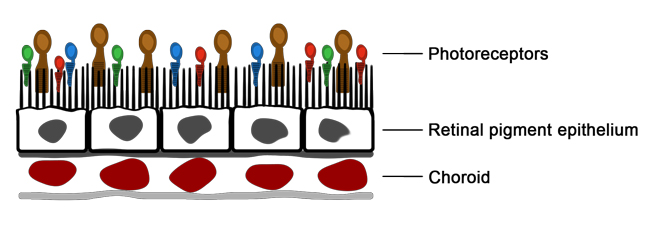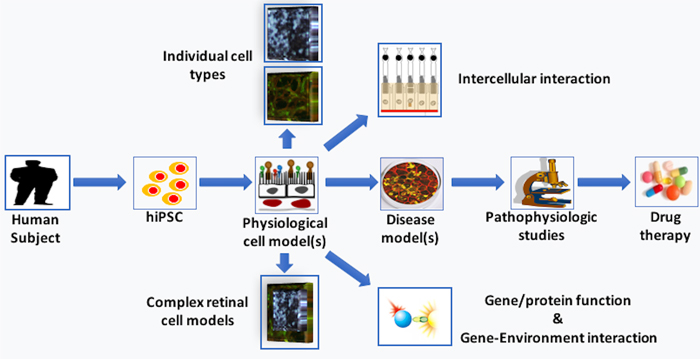Stem Cell & Disease Modeling Lab
The overall objective of our laboratory is to find treatments and possibly cures for specific retinal and neurodegenerative diseases. Towards this goal, our research program focuses on 1) understanding the normal physiology of the human retina, 2) using patient-derived human induced pluripotent stem cells (hiPSCs) to study the molecular mechanism of specific retinal and neurodegenerative diseases that affect the retina and 3) applying that knowledge to pharmacologically target certain retinal disorders in relevant animal models and patient-derived hiPSC-target cells. Furthermore, our specific focus for physiologic, disease modeling and pharmacological studies is the outer retina (the light sensing photoreceptor cells and its support epithelium, retinal pigment epithelium) and its underlying vascular support, the chorioid.

Organizational schematic of the Photoreceptor-RPE- choroid complex that is affected in numerous retinal degenerative diseases.
The current projects in the laboratory as detailed below in the Projects sub-section are focused on 1) delineating the role of specific genes/proteins (e.g. CLN3, TIMP3, EFEMP1) in retinal homeostasis, 2) investigating the molecular and cellular basis of specific diseases (e.g. age-related macular degeneration or AMD, Sorsby’s fundus dystrophy, Batten’s disease or CLN3) that affect the outer retina, 3) establishing a human cell model/tissue mimetic of the outer blood retinal barrier-vascular complex, 4) elucidating the role of gene-environment interaction in the pathophysiology of specific inherited maculopathies and AMD, 5) dissecting the role of local (retina-choroid specific) and systemic (e.g. serum) influences on development of macular degeneration phenotypes and 6) pharmacologically targeting the central disease hallmarks of AMD, drusen formation and extracellular matrix, in a patient-derived hiPSC model of macular degeneration. Altogether, our approach to studying retinal physiology and disease development in the laboratory is utilizing patient-derived human induced pluripotent stem cells (hiPSCs) is summarized in the following schematic:

Overall objective of the laboratory.

Ruchira Singh, Ph.D.
Principal Investigator
Projects
View All ProjectsPublications
View All Publications- A 3D iPSC retina model reveals non-cell-autonomous and non-neuronal mechanism of photoreceptor degeneration in a lysosomal storage disorder.; bioRxiv : the preprint server for biology. 2025 Jul 15.
- Protocol for immunofluorescence characterization of drusen in induced pluripotent stem cell-derived retinal pigment epithelium cultures.; STAR protocols; Vol 6(2), pp. 103791. 2025 May 02.
- Genetic and Cellular Basis of Impaired Phagocytosis and Photoreceptor Degeneration in CLN3 Disease.; Investigative ophthalmology & visual science; Vol 65(13), pp. 23. 2024 Nov 04.
- Human iPSC-based disease modeling studies identify a common mechanistic defect and potential therapies for AMD and related macular dystrophies.; Developmental cell. 2024 Sep 26.
- Tissue Inhibitor of Metalloproteinase 3 (TIMP3) mutations increase glycolytic activity and dysregulate glutamine metabolism in RPE cells.; Molecular metabolism. 2024 Jul 22.
- Genetic and cellular basis of impaired phagocytosis and photoreceptor degeneration in CLN3 disease.; bioRxiv : the preprint server for biology. 2024 Jun 13.
- A novel porcine model of CLN3 Batten disease recapitulates clinical phenotypes.; Disease models & mechanisms. 2023 Jun 12.
- Extracellular vesicles: an emerging player in retinal homeostasis.; Frontiers in cell and developmental biology; Vol 11, pp. 1059141. 2023 Apr 25.
- AMD recapitulated in a 3D biomimetic: A breakthrough in retina tissue engineering.; Cell stem cell; Vol 30(3), pp. 243-245. 2023 Mar 02.
Affiliations
News
October 21, 2024
Ruchira Singh, PhD, Appears on the People Behind the Science Podcast
October 2, 2024
New Research Offers Hope for Preventing Age-Related Blindness
March 30, 2021
First-ever lab model of human eye offers hope for macular degeneration patients
March 29, 2021
Lab model offers hope for macular degeneration patients
Lab Photos
Contact Us
Singh Lab
SMD 1.3026
601 Elmwood Ave
Rochester, NY 14642

















